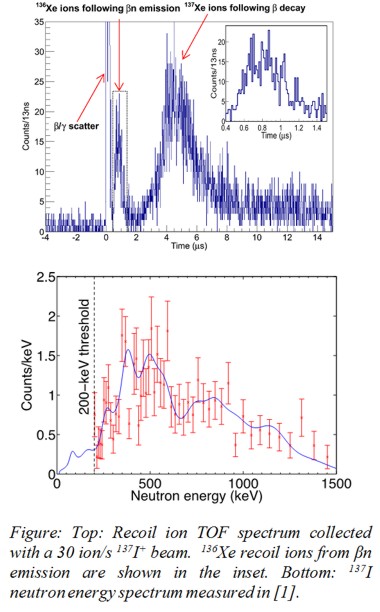Physics Division Research Highlights
Revolutionizing β-delayed neutron spectroscopy using trapped ions
Beta-delayed neutron (βn) emission is important to both the pure and applied nuclear physics communities. Neutron-emission branching ratios are needed to determine how the neutron-rich isotopes created in the r-process decay back to stability, and both branching ratios and energy spectra are required for the design and safety analyses of future Generation IV nuclear reactors. Delayed-neutron measurements also aid in the understanding of nuclear structure of neutron-rich nuclei and support the stockpile-stewardship mission. Recent βn measurements have revealed discrepancies as large as factors of 2-4 with existing data, warranting further experimental investigation.
 Historically, βn detection has dealt with significant experimental compromises, namely the detection of neutrons with high efficiency or modest energy resolution, but not both. Our technique circumvents the challenges with neutron detection by confining cooled radioactive ions to a ~ 1-mm3 volume in vacuum and studying the nuclear recoil. Neutron emission can be identified by measuring the β-recoil ion coincidence time of flight (TOF) as it leads to high-energy recoils with short TOFs.
Historically, βn detection has dealt with significant experimental compromises, namely the detection of neutrons with high efficiency or modest energy resolution, but not both. Our technique circumvents the challenges with neutron detection by confining cooled radioactive ions to a ~ 1-mm3 volume in vacuum and studying the nuclear recoil. Neutron emission can be identified by measuring the β-recoil ion coincidence time of flight (TOF) as it leads to high-energy recoils with short TOFs.
In 2011, a proof-of-principle experiment was conducted by studying a standard βn precursor, 137I [1]. Ions were confined in a linear Paul trap [2], with a plastic scintillator and microchannel plate (MCP) for β and recoil-ion detection, respectively. For the first time, a neutron energy spectrum was reconstructed from the β-recoil ion TOF, and the neutron branching ratio was determined three ways as a check of systematic effects by comparing the high-energy recoils to the low-energy recoil ions following β decay, β-delayed γ rays, and β singles.
A new, dedicated trap and detector array are being designed and will be sited at CARIBU. Here, the neutron-energy resolution will be improved to ~ 5% FWHM by better determining ion trajectories with position-sensitive MCPs and the spectrum can be measured to energies as low as 25-50 keV. Additional β and MCP detectors will increase the detection efficiency by a factor of ~ 40 (from 0.05% to 2%), allowing measurements to be performed on ion beams as weak as 0.1-1 ion/s.
References
[1] R.M. Yee et al., Phys. Rev. Lett. 101, 092501(2013).
[2] N.D. Scielzo et al., Nucl. Instr. and Meth. A 681, 94 (2012).
![[Argonne Logo]](/images/argonne_header_logo.jpg)
![[DOE Logo]](/images/header_doe.gif)